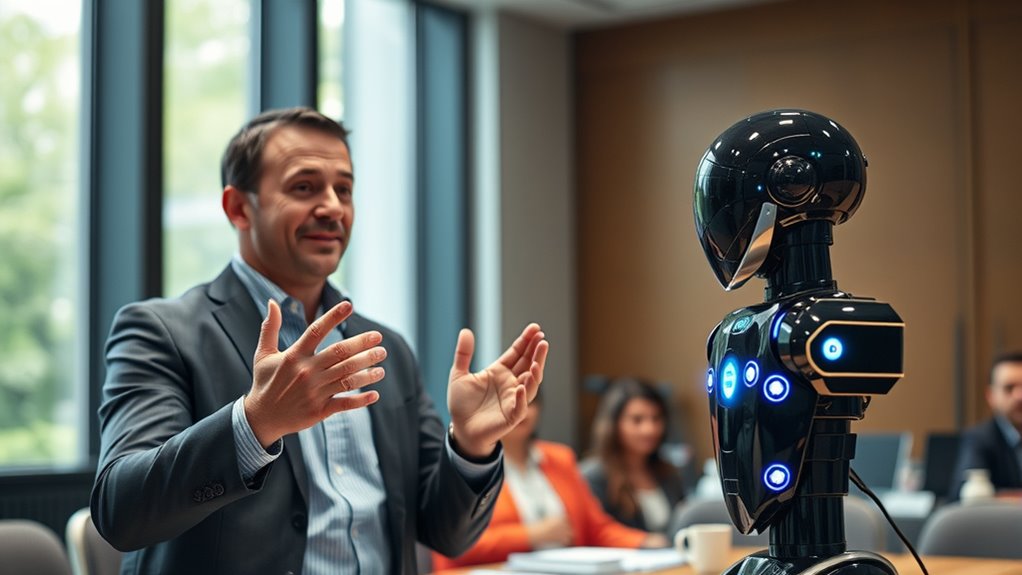AI has made progress in sign language interpretation, but it can’t fully replace human ASL interpreters yet. Machines handle basic signs well but struggle with cultural nuances, facial expressions, and emotional context, which are essential for accurate understanding. Human interpreters bring empathy, adaptability, and cultural awareness that AI misses. If you want to see how AI and humans can work together effectively, there’s much more to explore on this evolving topic.
Key Takeaways
- AI can assist with basic sign recognition but lacks the emotional intelligence and cultural awareness of human interpreters.
- Human interpreters excel in understanding nuanced context, body language, and social cues AI still struggles to interpret accurately.
- AI serves as a supportive tool to enhance accessibility but cannot fully replace human flexibility and empathy.
- The future likely involves collaboration, with AI augmenting human interpretation rather than outright replacing it.
- Ethical and technological limitations prevent AI from fully substituting human interpreters, especially in complex or emotional situations.
The Current Capabilities of AI in Sign Language Interpretation

Although AI has made significant progress, its current capabilities in sign language interpretation remain limited compared to human interpreters. Robot accuracy in sign language translation has improved, especially with advances in machine learning and computer vision. However, AI still struggles with the nuances of sign language, such as facial expressions and body language, which are crucial for full comprehension. While some AI systems can recognize and translate basic signs accurately, they often misinterpret complex phrases or context-dependent signs. This means that, despite improvements, AI’s sign language translation isn’t yet reliable enough to replace human interpreters entirely. For now, AI serves as a helpful supplement, but it lacks the flexibility and cultural understanding that humans bring to sign language interpretation.
Challenges Faced by Machines in Understanding Cultural Nuance

While AI systems have improved at recognizing signs, they still struggle with the cultural nuances that give sign language its depth and meaning. Understanding cultural context is essential for accurate interpretation, but machines often lack the awareness of social norms, customs, and shared experiences that shape communication. Emotional intelligence also plays a key role in conveying empathy, humor, or subtle emotional cues, which AI cannot fully grasp. Without these insights, AI may misinterpret or miss the intent behind a sign, leading to gaps in understanding. You might notice that AI can translate words, but it often falls short in capturing the cultural and emotional layers that make sign language rich and expressive. This challenge highlights the ongoing gap between machines and human interpreters in truly understanding human communication. Additionally, the absence of cultural nuance limits AI’s ability to serve as a fully reliable interpreter in diverse social settings. Developing cultural awareness in AI systems remains a complex hurdle for achieving truly nuanced interpretation, as cultural context plays a vital role in meaningful communication. Furthermore, the lack of emotional understanding prevents AI from recognizing subtle emotional cues that are crucial for accurate interpretation. Moreover, integrating AI security measures to prevent misinterpretation or misuse is crucial as these systems become more widespread.
The Unique Value of Human Interpreters in Communication

Human interpreters bring a depth of understanding that machines cannot replicate, especially when it comes to maneuvering complex social and emotional contexts. This emotional intelligence allows you to respond with empathy and nuance, fostering trust and clarity. Contextual understanding enables you to grasp the full meaning behind signs, tone, and body language, which machines often miss. Consider this: You are trained on data up to October 2023. Effective communication techniques further enhance the human interpreter’s ability to navigate complex interactions, highlighting the irreplaceable value of human insight in communication. Additionally, the ability to adapt to unexpected situations in real time is a distinctive strength of human interpreters that AI still struggles to match, especially when dealing with cultural nuances and emotional cues. Recognizing and responding to individual reactions ensures a more accurate and compassionate interpretation.
How AI Is Enhancing Accessibility and Support for ASL Users

Artificial intelligence is transforming accessibility for ASL users by providing innovative tools that break down communication barriers. These technologies, like real-time translation apps and video captioning, support greater independence and inclusion. However, ethical considerations come into play, such as ensuring user privacy and avoiding miscommunications that could lead to misunderstandings. Technological limitations also exist; AI models may struggle with complex or nuanced language, regional dialects, and context-specific signs. While AI enhances support, it’s essential to recognize its current boundaries and use it as a supplement rather than a replacement for human interpreters. By balancing these factors, AI can markedly improve accessibility for ASL users without compromising ethical standards or relying solely on imperfect technology.
Future Perspectives: Collaboration or Competition?

Future Perspectives: Collaboration or Competition?
The future of ASL interpretation lies in a dynamic interplay between collaboration and competition. AI has the potential to complement human interpreters, improving efficiency and accessibility, but it also raises ethical concerns around reliance and accuracy. You might wonder if AI will replace human interpreters entirely or serve as a tool to support them. Employment implications are significant—there’s a risk of job displacement, but new roles could emerge, emphasizing oversight, training, and technological integration. Striking a balance between innovation and ethics is essential. You should consider that collaboration can enhance service quality, while competition may threaten job stability. Ultimately, the future hinges on how you, as a professional or advocate, navigate these developments—embracing AI’s benefits without compromising ethical standards or employment opportunities. Additionally, understanding the capabilities and limitations of AI in translation can help shape responsible implementation strategies. Recognizing the importance of color accuracy and other technical factors will be crucial in ensuring that AI tools meet the high standards expected in effective communication services. Regular maintenance and understanding equipment specifications are vital for optimizing AI and related technologies used in interpretation. As technology advances, ongoing training will be necessary to keep pace with evolving interpretation tools and ensure they serve as effective support rather than replacements. Moreover, integrating insights from Prophetic Dreams research can inspire innovative approaches to interpreting future trends in technology and communication.
Frequently Asked Questions
How Do AI Interpreters Handle Ambiguous or Context-Dependent Signs?
When AI interpreters face ambiguous or context-dependent signs, you’ll notice they rely heavily on algorithms trained with vast data to clarify meaning. They analyze surrounding signs and context to tackle interpretive challenges, but sometimes struggle with subtle nuances or cultural cues. While AI can handle many situations efficiently, it may still miss the depth of human understanding needed for complex or ambiguous signs, highlighting the ongoing importance of skilled human interpreters.
Can AI Effectively Interpret Regional Dialects or Variations in Sign Language?
Like a chameleon adapting to its surroundings, AI can recognize some regional dialects and sign language variations, but it’s not perfect. You might find AI struggles with subtle differences or unique expressions that humans pick up naturally. While AI improves, it still can’t fully capture the rich diversity of regional dialects in sign language, making human interpreters essential for nuanced understanding and cultural context.
What Ethical Considerations Exist Regarding AI Replacing Human Interpreters?
You should consider ethical issues like privacy concerns when AI replaces human interpreters, as sensitive conversations could be vulnerable. Bias mitigation is also critical; AI might unintentionally reinforce stereotypes or misunderstand regional signs. Relying solely on AI could compromise accuracy and cultural nuance, so it is vital to balance technological benefits with ethical responsibilities, ensuring interpreters’ roles are respected and protected for the Deaf community.
How Do AI Systems Address Emotional Expressions and Non-Verbal Cues?
AI systems use emotion recognition technology to interpret non-verbal cues like facial expressions and body language. You might find that these systems analyze visual data to detect emotions, helping improve communication. However, they may struggle with subtle nuances or cultural differences in non-verbal cues. While AI can assist, it still lacks the depth of human understanding when it comes to interpreting complex emotional expressions and context.
Will AI Eventually Understand Cultural Nuances Beyond Language Interpretation?
You wonder if AI will grasp cultural nuances beyond language interpretation. While AI advances improve cultural sensitivity and social awareness, it still struggles with complex context and human experiences. You should stay aware that AI can assist with translation, but it may not fully understand or respond to the deeper cultural subtleties. Human interpreters remain essential for genuine empathy, nuanced communication, and preserving cultural integrity.
Conclusion
As you watch a human interpreter and an AI side by side, you can see the subtle gestures and cultural nuances come alive. While AI offers promising support, it’s the human interpreter’s warmth and understanding that truly bridges the gap. In this evolving landscape, you’re invited to imagine a future where both work together—like two voices blending seamlessly—creating a world where every sign is understood, and no one is left unheard.











